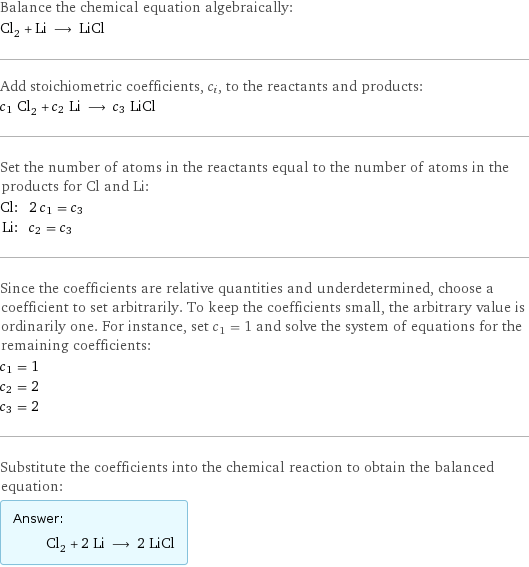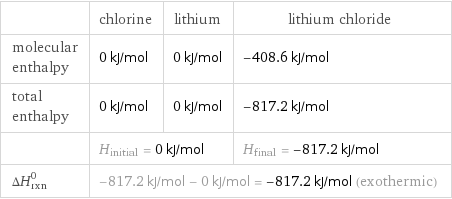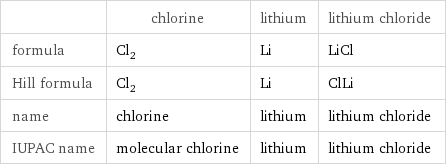Input interpretation

Cl_2 (chlorine) + Li (lithium) ⟶ LiCl (lithium chloride)
Balanced equation

Balance the chemical equation algebraically: Cl_2 + Li ⟶ LiCl Add stoichiometric coefficients, c_i, to the reactants and products: c_1 Cl_2 + c_2 Li ⟶ c_3 LiCl Set the number of atoms in the reactants equal to the number of atoms in the products for Cl and Li: Cl: | 2 c_1 = c_3 Li: | c_2 = c_3 Since the coefficients are relative quantities and underdetermined, choose a coefficient to set arbitrarily. To keep the coefficients small, the arbitrary value is ordinarily one. For instance, set c_1 = 1 and solve the system of equations for the remaining coefficients: c_1 = 1 c_2 = 2 c_3 = 2 Substitute the coefficients into the chemical reaction to obtain the balanced equation: Answer: | | Cl_2 + 2 Li ⟶ 2 LiCl
Structures

+ ⟶
Names

chlorine + lithium ⟶ lithium chloride
Reaction thermodynamics
Enthalpy

| chlorine | lithium | lithium chloride molecular enthalpy | 0 kJ/mol | 0 kJ/mol | -408.6 kJ/mol total enthalpy | 0 kJ/mol | 0 kJ/mol | -817.2 kJ/mol | H_initial = 0 kJ/mol | | H_final = -817.2 kJ/mol ΔH_rxn^0 | -817.2 kJ/mol - 0 kJ/mol = -817.2 kJ/mol (exothermic) | |
Equilibrium constant
![K_c = [LiCl]^2/([Cl2] [Li]^2)](../image_source/096f04d4c18d42d22c7d5814d329a139.png)
K_c = [LiCl]^2/([Cl2] [Li]^2)
Rate of reaction
![rate = -(Δ[Cl2])/(Δt) = -1/2 (Δ[Li])/(Δt) = 1/2 (Δ[LiCl])/(Δt) (assuming constant volume and no accumulation of intermediates or side products)](../image_source/1eaae7d9e44f1a313bec178e54524d80.png)
rate = -(Δ[Cl2])/(Δt) = -1/2 (Δ[Li])/(Δt) = 1/2 (Δ[LiCl])/(Δt) (assuming constant volume and no accumulation of intermediates or side products)
Chemical names and formulas

| chlorine | lithium | lithium chloride formula | Cl_2 | Li | LiCl Hill formula | Cl_2 | Li | ClLi name | chlorine | lithium | lithium chloride IUPAC name | molecular chlorine | lithium | lithium chloride
Substance properties

| chlorine | lithium | lithium chloride molar mass | 70.9 g/mol | 6.94 g/mol | 42.4 g/mol phase | gas (at STP) | solid (at STP) | solid (at STP) melting point | -101 °C | 180 °C | 605 °C boiling point | -34 °C | 1342 °C | 1382 °C density | 0.003214 g/cm^3 (at 0 °C) | 0.534 g/cm^3 | 2.07 g/cm^3 solubility in water | | decomposes | surface tension | | 0.3975 N/m | dynamic viscosity | | | 0.00525 Pa s (at 20 °C)
Units
